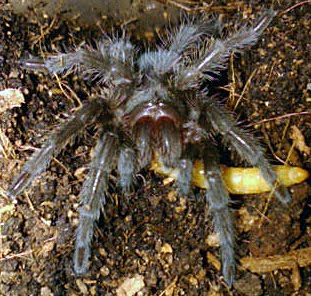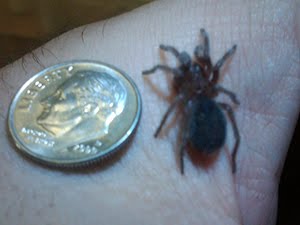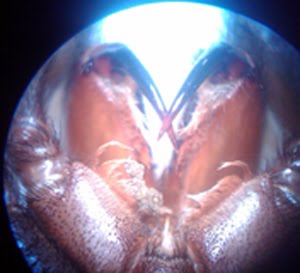A must read for all tarantula enthusiasts is The Tarantula Keepers Guide: Comprehensive Information on Care, Housing, and Feeding, by S.A. Schultz, and M.J. Schultz Tarantula Keepers Guide
Range: Brazil and Uruguay grasslands (Pampas)
Type: Terrestrial, opportunistic burrower
Size: 6-8 inches when fully grown
Growth Rate: can reach ~4" in first year, slow after that
Temperament: Docile and calm
Diet: Spiderlings will eat pinhead crickets, roach nymphs, and other small insects; 1-2 prey items every other day.
Adults eat crickets, other large insects, such as various species of roaches; 3-8 prey items per month depending on prey size. Be sure the prey item is not larger than the overall body size (prosoma) of the tarantula.
Temperature: The lower and upper ranges for good health are between 65° and 85° Fahrenheit. Keep in mind that temperatures fluctuate wildly in nature, and tarantulas are quite adaptable creatures. While they will survive at room temperatures, this species seems to thrive at temperatures between 75° and 85°.
Humidity/Water Requirements: Spiderlings will require light misting on the sides of the enclosure to drink droplets of water, and a moist substrate until they reach about 1" diagonal leg span. All tarantulas that have at least a 1" leg span may drink from a shallow water dish. While tarantulas get most of their hydration from the their prey, clean fresh water should be provided at all times. For G pulchra, a full water dish with moist substrate around the dish will provide enough humidity to keep them healthy.
Lighting: While there are no special lighting requirements for any tarantula species, G. pulchra seems to enjoy basking near light. I currently use full spectrum (grow lights) 15 watt florescent lights near my enclosures and all of my G. pulchra will go to the light and sit right next to it.
Housing
Spiderlings: Can live in a small clear plastic deli-container with air holes poked around the upper rim with a heated pin. Use enough substrate to create a 3-4 inch deep layer when packed for burrowing, such as peat moss, peat humus, ground coco fiber, or a mixture of any of these. The substrate should retain enough moisture to clump together when squeezed, but not drip water. Until reaching a 1" leg span, droplets of water should be provided for hydration and humidity on the side of the enclosure through light misting with a spray bottle a couple times a week (be sure not to spray your spiderling directly). A water bowl should be given when the tarantula reaches a leg span of 1"; A plastic water bottle cap is ideal for maintaining hydration while keeping the tarantula's booklungs out of the water. Place a small stone in the water dish to give prey a means of escaping drowning. As the tarantula grows be sure to always provide a water dish, with freshwater, that is slightly less than the leg span of the tarantula. Spiderlings need to burrow to help them maintain body fluids and feel secure.
Adults: Can be kept in a semi-arid set-up. They will do well in a 10 gallon aquarium, or similarly sized enclosure with a strong secure lid. Keep in mind they use their fangs to dig in hard packed soil and can chew through many materials; plastic, nylon, and aluminum mesh will not stop a tarantula. Floor space is more important than height, but don't over do it. Many tarantulas rarely venture more than a few leg spans from their homes (though, anecdotal evidence suggests they may travel further). An enclosure should be no more than 3 times the leg span and no less than 2 times the leg span in any measurement. Substrate such as peat moss, peat humus, ground coco fiber, or a mixture of any of these should be used. Lightly moisten substrate and add enough to create a 5-6 inch layer (for burrowing) when gently packed. Adults do not require as much moisture as the spiderlings do; allow the upper 3-4 inches of substrate to dry out, while keeping the lower 2-3 inches lightly moist. Provide a piece of cork bark, small coconut shell, partial clay pot, or similar item to create a hide. Decorations are not necessary, except for your own eye appeal. Be sure all decorations are safe for the tarantula before placing them into the enclosure.
G. pulchra is an opportunistic burrowing species. Providing a hide may discourage burrowing, but is no guarantee.
Always house tarantulas separately, to prevent cannibalism.
You should follow this link for more detailed care guidelines Tarantula Care
For very detailed instructions on how to care for young tarantulas try Spiderling Care
Set-up for my ~2" Grammostola pulchra (December 15, 2009 -January29, 2010)
16oz deli cup for single tarantula (top 10.5cm diameter, bottom 8.5cm diameter, height 11.5cm). Water bottle cap for water, coco fiber and pete humus substrate damp enough to clump when squeezed, but not drip. Packed substrate fills 2/3 of this cup. Don't forget the lid(not shown). I use insect lids with a mesh fabric, or use a 3mm diameter nail to perforate the lid and upper rim of the cup for ventilation.
10 gallon aquarium housing the four separate deli cups:
There is a small reptile heat pad affixed to the inside rear wall of the aquarium to maintain a stable temperature of ~25C. Two thermometers record the temperature at the rear and the front to obtain an average reading. The cup is filled with water to help maintain humidity. There is no light installed, the bright spot is the glare from the camera flash. The aquarium is fitted with a perforated cardboard lid to help retain heat and humidity.
Set-up for +2" Grammostola pulchra, after January 2010 molt (re-housed on January 29, 2010)
After having molted in January 2010 the spiderlings had increased in size and were ready for a larger enclosure. The smallest dimension of an enclosure should be about 3 times the leg span of the tarantula. The new enclosures, (4) one for each spiderling, are 3.8 liter (1g) plastic storage containers measuring 15.2cm x 15.2cm x 27.9cm with 2mm holes near the upper rim for ventilation. The substrate is coconut fiber and pete humus, packed firm to depth of 10cm. A 8oz. Styrofoam cup was buried in the center to take up some of the volume (less substrate to fill the container) and to force burrowing along the edges of the container. This allows burrows to be visible through the sides of the container. Moss was added to help maintain humidity, and for eye appeal. A small starter burrow was placed in the front right corner.

 | |||
| Number1 Exploring the new home |
Set-up for adult G. pulchra
10 Gallon glass aquarium measuring 10"w x 20"l x 12"h. Substrate is coco fiber packed to a depth of 6". The lower 2" of substrate are kept lightly moist. Below is the enclosure for 009; 008 and 010 are in the same type of set-up, with the hides being the only difference - 008 has a crocodile skull and 010 has a triceratops skull.
 |
| 009 in his corner, he rarely leaves it |












